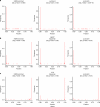A comprehensive overview of genomic imprinting in breast and its deregulation in cancer
- PMID: 30297886
- PMCID: PMC6175939
- DOI: 10.1038/s41467-018-06566-7
A comprehensive overview of genomic imprinting in breast and its deregulation in cancer
Abstract
Genomic imprinting plays an important role in growth and development. Loss of imprinting (LOI) has been found in cancer, yet systematic studies are impeded by data-analytical challenges. We developed a methodology to detect monoallelically expressed loci without requiring genotyping data, and applied it on The Cancer Genome Atlas (TCGA, discovery) and Genotype-Tissue expression project (GTEx, validation) breast tissue RNA-seq data. Here, we report the identification of 30 putatively imprinted genes in breast. In breast cancer (TCGA), HM13 is featured by LOI and expression upregulation, which is linked to DNA demethylation. Other imprinted genes typically demonstrate lower expression in cancer, often associated with copy number variation and aberrant DNA methylation. Downregulation in cancer frequently leads to higher relative expression of the (imperfectly) silenced allele, yet this is not considered canonical LOI given the lack of (absolute) re-expression. In summary, our novel methodology highlights the massive deregulation of imprinting in breast cancer.
Conflict of interest statement
The authors declare no competing interests.
Figures





References
Publication types
MeSH terms
LinkOut - more resources
Full Text Sources
Other Literature Sources
Medical
Miscellaneous

